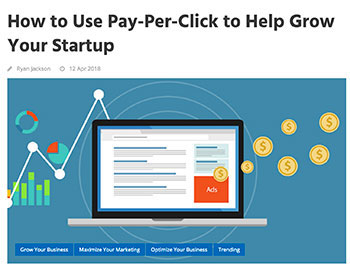If you're looking to launch a new business, having a company blog needs to be one of your top priorities from day one.
An engaging, value-driven blog will become a core part of your digital marketing strategy, a key tool for attracting customers, driving revenue and building your brand.
In today's crowded online marketplace, simply having a website is not enough. You need fresh, search-engine-optimised content constantly flowing onto your site. This is where blogging comes in — regular blog posts will boost your SEO rankings, position you as an authority in your niche and allow you to directly reach and interact with your target audience.
Here, we’ll explore why your blog should be a foundational piece of your website, the tangible financial upsides of regular content and, finally, how to strategically approach business blogging right from launch.
Why your blog is a key part of your website
Having a company blog integrated into your website provides several advantages that can significantly impact your startup's growth.
Attract the right customers
Firstly, fresh blog content gives people a reason to keep coming back to your site. Well-written posts will
attract new visitors organically through search engines like Google, and existing customers will return to check out your latest musings. This regular stream of blog readers will steadily grow your overall website traffic. Just be sure that
the content you’re writing is aimed at your target customers for the biggest impact.
SEO advantages
Another benefit of blogging regularly is that it forms
part of your search engine optimisation strategy, which is crucial for any business today. The major search engines, especially Google, place significant weight on regular new content when ranking sites. An active blog publishing regular posts optimised with relevant keywords will boost your search rankings and visibility.
Demonstrate thought leadership
Blogging allows you to
highlight your startup's knowledge, insights and expertise in your industry niche. You can establish your team members as trusted thought leaders by having them pen their own blogs, which lends credibility. Customers find this reassuring when making purchasing decisions, so it can help with conversions in the long-term.
Strengthen customer relationships
A blog creates touchpoints to interact with and engage your audience. Through valuable posts, you can nurture leads, address customer pain points and build relationships, because readers who comment on posts feel invested in your business. You can even invite guest contributions as an opportunity to connect further.
Drive more conversions
Quality blog content will increase both the quantity and quality of your website traffic. By publishing posts optimised for keywords that your potential customers are searching, you draw in relevant visitors who are already interested in your products or services. Your blog allows you to educate and influence these visitors, making them more likely to convert into paying customers. Consistently nurturing leads via blog posts will directly translate into increased conversions.
Generate leads
A blog gives you a platform to call readers to take specific actions through strategic calls-to-action in your posts. You can invite them to sign up for a newsletter, download an ebook, request a demo, attend a webinar and much more. These will allow you to generate and
nurture leads through the sales funnel.The more quality leads from your blog, the higher your revenue potential.
How to develop a successful blog
Now you know the benefits of blogging, where do you start in developing your own? Here are a few top tips for a successful blog strategy.
Plan your content strategy
Decide on the topics you will cover on your blog. along with the style and tone of voice you’ll strive for, your publishing frequency and other details which will allow you to maintain consistency. Make sure that whatever you decide aligns with your overall marketing strategy and goals. It may help to research what your audience cares about and wants to read, or common questions they have within your industry that you can help with; look at what competitors are covering as well so you can craft content that provides value, solves problems and promotes your offerings.
Optimise for SEO
Research relevant keyword terms your audience is searching for and optimise your posts for these by including keywords in your titles, URLs, meta descriptions, image tags and naturally within the content. This boosts visibility and traffic, but don't overdo it — write for readers first before keywords, so that the keywords feature naturally.
Promote your blog posts
Leverage social media channels like Twitter, LinkedIn and Facebook to maximise reach for your blog content and share posts on relevant groups. You can also email your subscribers, inviting them to check out new posts. Promote your best content repeatedly over time to build a strong and loyal following of readers.
Set a blogging schedule
Consistency is the key for engaging readers and search engines. Commit to a regular posting cadence, at least once or twice a week, and stick to it. But remember not to make promises you can't keep; it's better to under-promise and over-deliver when starting out. You want your audience to be able to rely on when they’ll see a new post from you.
Analyse and refine
Use analytics to see which posts perform best, so you can double down on those topics and styles. It’s also important to pay attention to reader comments; these offer valuable insights.
Look at clicks, time on page and shares, enabling you to continually refine your approach based on data and feedback.
The advantages of business blogging are numerous. You can increase website visitors through better search engine rankings, demonstrate your startup's expertise by publishing insightful content and engage customers and nurture leads through valuable posts. But equally importantly, blogging delivers concrete commercial benefits. The regular influx of website visitors and leads translates directly into more conversions and revenue. While launching a blog requires some effort upfront, the long-term dividends are well worth it. And, luckily, the steps to getting started are straightforward.
Guest writer







